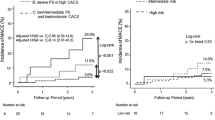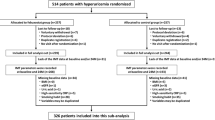Abstract
The objective of the study is to assess the prevalence of target organ damage (TOD) at carotid, cardiac, renal and peripheral vascular levels in a population at intermediate cardiovascular risk, with adjunctive major risk factors (AMRF). From March 2007 to July 2009 we examined 979 subjects at intermediate cardiovascular risk, as indicated by the Italian algorithm “Progetto Cuore”; the patients were aged 40–69 years, sensitized by one or more AMRF such as family history for cardiovascular disease (CVD), being overweight or obese, and smoking habit (more than 10 cigarettes/day). We measured common carotid intima–media thickness (cc-IMT) and plaque at any level, left ventricular mass index (LVMI), urine albumin/creatinine ratio (UACR), and ankle-brachial index (ABI). The prevalence of at least one TOD was 63% (617 subjects), cc-IMT was high in 48.2% (472), UACR abnormal in 14.1% (138), LVMI high in 12.6% (117) and ABI pathological in 9.1% (89). In those with carotid damage 423 had a plaque, amounting to 43.2% of the total population. Of note, carotid damage was present in all subjects with 3 TODs, and in 92% of subjects with 2 TODs. A multivariate logistic regression model including conventional factors and AMRF indicated that age 50–69 years, systolic blood pressure, relevant smoking and CV risk score ≥15 were independently and significantly associated with at least one TOD, and at least, with carotid damage. Among the AMRF, peripheral arterial disease was associated with relevant smoking, with an odds ratio (OR) of 3 [confidence interval (CI) 1.80–4.97, p < 0.0001]; overweight and obesity both had selective associations with cardiac damage with OR 2.75 (CI 1.2–6.3, p < 0.01) and OR 3.89 (CI 1.61–9.73, p < 0.01). A substantial proportion of people at intermediate risk, with at least one AMRF have at least one TOD, a major predictor of cardiovascular outcomes.


Similar content being viewed by others
References
Lopez AD, Mathers CD, Ezzati M, Jamison DT, Murray CJ (2006) Global and regional burden of disease and risk factors, 2001: systematic analysis of population health data. Lancet 367:1747–1757
Tunstall-Pedoe H, Kuulasmaa K, Mahonen M, Tolonen H, Ruokokoski E, Amouyel P (1999) Contribution of trends in survival and coronary-event rates to changes in coronary heart disease mortality: 10-year results from 37 WHO MONICA project populations. Monitoring trends and determinants in cardiovascular disease. Lancet 353:1547–1557
Khot UN, Khot MB, Bajzer CT, Sapp SK, Ohman EM, Brener SJ et al (2003) Prevalence of conventional risk factors in patients with coronary heart disease. JAMA 290:898–904
Smith SC Jr, Greenland P, Grundy SM (2000) Prevention conference V: beyond secondary prevention: identifying the high-risk patient for primary prevention. Executive summary. Circulation 101:111–116
Greenland P, Smith SC Jr, Grundy SM (2001) Improving coronary heart disease risk assessment in asymptomatic people: role of traditional risk factors and noninvasive cardiovascular tests. Circulation 104:1863–1867
Executive Summary of The Third Report of The National Cholesterol Education Program (NCEP) Expert panel on detection, evaluation, and treatment of high blood cholesterol in adults (Adult Treatment Panel III) (2001) JAMA 285:2486–2497
Palmieri L, Panico S, Vanuzzo D, Ferrario M, Pilotto L, Sega R et al (2004) Evaluation of the global cardiovascular absolute risk: the Progetto CUORE individual score. Ann Ist Super Sanita. 40:393–399
Assmann G, Cullen P, Schulte H (2002) Simple scoring scheme for calculating the risk of acute coronary events based on the 10-year follow-up of the prospective cardiovascular Munster (PROCAM) study. Circulation 105:310–315
Conroy RM, Pyorala K, Fitzgerald AP, Sans S, Menotti A, De BG et al (2003) Estimation of ten-year risk of fatal cardiovascular disease in Europe: the SCORE project. Eur Heart J 24:987–1003
Collins GS, Altman DG (2009) An independent external validation and evaluation of QRISK cardiovascular risk prediction: a prospective open cohort study. BMJ 339:b2584
Kannel WB, Dawber TR, Kagan A, Revotskie N, Stokes J (1961) Factors of risk in the development of coronary heart disease—six years follow-up experience: the Framingham Study Ann Intern Med 55:33–50
Michos ED, Vasamreddy CR, Becker DM, Yanek LR, Moy TF, Fishman EK et al (2005) Women with a low Framingham risk score and a family history of premature coronary heart disease have a high prevalence of subclinical coronary atherosclerosis. Am Heart J 150:1276–1281
Ridker PM, Buring JE, Rifai N, Cook NR (2007) Development and validation of improved algorithms for the assessment of global cardiovascular risk in women: the Reynolds Risk Score. JAMA 297:611–619
Pearson TA, Blair SN, Daniels SR, Eckel RH, Fair JM, Fortmann SP et al (2002) AHA Guidelines for Primary Prevention of Cardiovascular Disease and Stroke: 2002 update: consensus panel guide to comprehensive risk reduction for adult patients without coronary or other atherosclerotic vascular diseases. American Heart Association Science Advisory and Coordinating Committee. Circulation 106:388–391
Fiscella K, Tancredi D, Franks P (2009) Adding socioeconomic status to Framingham scoring to reduce disparities in coronary risk assessment. Am Heart J 157:988–994
Mancia G, De BG, Dominiczak A, Cifkova R, Fagard R, Germano G, et al. (2007) 2007 Guidelines for the management of arterial hypertension: The Task Force for the Management of Arterial Hypertension of the European Society of Hypertension (ESH) and of the European Society of Cardiology (ESC) Eur Heart J 2007 28:1462–1536
Law MR, Morris JK, Wald NJ (2009) Use of blood pressure lowering drugs in the prevention of cardiovascular disease: meta-analysis of 147 randomised trials in the context of expectations from prospective epidemiological studies. BMJ. 338:b1665
Greving JP, Buskens E, Koffijberg H, Algra A (2008) Cost-effectiveness of aspirin treatment in the primary prevention of cardiovascular disease events in subgroups based on age, gender, and varying cardiovascular risk. Circulation. 117:2875–2883
Ridker PM, Danielson E, Fonseca FA, Genest J, Gotto AM Jr, Kastelein JJ et al (2008) Rosuvastatin to prevent vascular events in men and women with elevated C-reactive protein. N Engl J Med 359:2195–2207
Lloyd-Jones DM (2010) Cardiovascular risk prediction: basic concepts, current status and future directions. Circulation 121:1768–1777
Desai MY, Nasir K, Braunstein JB, Rumberger JA, Post WS, Budoff MJ et al (2004) Underlying risk factors incrementally add to the standard risk estimate in detecting subclinical atherosclerosis in low- and intermediate-risk middle-aged asymptomatic individuals. Am Heart J 148:871–877
Ambrosetti M, Pedretti RF (2008) Does metabolic syndrome predict silent carotid stenosis in coronary patients? Intern Emerg Med 3:81–82
Yusuf S, Hawken S, Ounpuu S, Dans T, Avezum A, Lanas F et al (2004) Effect of potentially modifiable risk factors associated with myocardial infarction in 52 countries (the INTERHEART study): case–control study. Lancet 364:937–952
Scott IA (2009) Evaluating cardiovascular risk assessment for asymptomatic people. BMJ 338:a2844
Baldassarre D, Porta B, Camera M, Amato M, Arquati M, Brusoni B et al (2009) Markers of inflammation thrombosis and endothelial activation correlate with carotid IMT regression in stable coronary disease after atorvastatin treatment. Nutr Metab Cardiovasc Dis 19:481–490
Arnlov J, Evans JC, Meigs JB, Wang TJ, Fox CS, Levy D et al (2005) Low-grade albuminuria and incidence of cardiovascular disease events in nonhypertensive and nondiabetic individuals: the Framingham Heart Study. Circulation 112:969–975
Ankle Brachial Index Collaboration (2008) Ankle brachial index combined with Framingham risk score to predict cardiovascular events and mortality: a meta-analysis. JAMA 300:197–208
Lorenz MW, Markus HS, Bots ML, Rosvall M, Sitzer M (2007) Prediction of clinical cardiovascular events with carotid intima–media thickness: a systematic review and meta-analysis. Circulation 115:459–467
Sehestedt T, Jeppesen J, Hansen TW, Rasmussen S, Wachtell K, Ibsen H et al (2009) Which markers of subclinical organ damage to measure in individuals with high normal blood pressure? J Hypertens 27:1165–1171
Ingelsson E, Sullivan LM, Fox CS, Murabito JM, Benjamin EJ, Polak JF et al (2007) Burden and prognostic importance of subclinical cardiovascular disease in overweight and obese individuals. Circulation 116:375–384
Hirsch AT, Haskal ZJ, Hertzer NR, Bakal CW, Creager MA, Halperin JL et al (2006) ACC/AHA Guidelines for the Management of Patients with Peripheral Arterial Disease (lower extremity, renal, mesenteric, and abdominal aortic): a collaborative report from the American Associations for Vascular Surgery/Society for Vascular Surgery, Society for Cardiovascular Angiography and Interventions, Society for Vascular Medicine and Biology, Society of Interventional Radiology, and the ACC/AHA Task Force on Practice Guidelines (writing committee to develop guidelines for the management of patients with peripheral arterial disease)—summary of recommendations. J Vasc Interv Radiol 17:1383–1397
Lang RM, Bierig M, Devereux RB, Flachskampf FA, Foster E, Pellikka PA et al (2005) Recommendations for chamber quantification: a report from the American Society of Echocardiography’s Guidelines and Standards Committee and the Chamber Quantification Writing Group, developed in conjunction with the European Association of Echocardiography, a branch of the European Society of Cardiology. J Am Soc Echocardiogr 18:1440–1463
Prati P, Vanuzzo D, Casaroli M, Di CA, De BF, Feruglio GA et al (1992) Prevalence and determinants of carotid atherosclerosis in a general population. Stroke 23:1705–1711
Arnlov J, Ingelsson E, Sundstrom J, Lind L (2010) Impact of body mass index and the metabolic syndrome on the risk of cardiovascular disease and death in middle-aged men. Circulation 121:230–236
Gottdiener JS, Reda DJ, Materson BJ, Massie BM, Notargiacomo A, Hamburger RJ et al (1994) Importance of obesity, race and age to the cardiac structural and functional effects of hypertension. The Department of Veterans Affairs Cooperative Study Group on Antihypertensive Agents. J Am CollCardiol 24:1492–1498
Simon A, Megnien JL, Chironi G (2010) The value of carotid intima–media thickness for predicting cardiovascular risk. Arterioscler Thromb Vasc Biol 30:182–185
Cournot M, Taraszkiewicz D, Cambou JP, Galinier M, Boccalon H, Hanaire-Broutin H et al (2009) Additional prognostic value of physical examination, exercise testing and arterial ultrasonography for coronary risk assessment in primary prevention. Am Heart J 158:845–851
Redberg RF, Benjamin EJ, Bittner V, Braun LT, Goff DC Jr, Havas S et al (2009) ACCF/AHA 2009 performance measures for primary prevention of cardiovascular disease in adults: a report of the American College of Cardiology Foundation/American Heart Association task force on performance measures (writing committee to develop performance measures for primary prevention of cardiovascular disease): developed in collaboration with the American Academy of Family Physicians; American Association of Cardiovascular and Pulmonary Rehabilitation; and Preventive Cardiovascular Nurses Association: endorsed by the American College of Preventive Medicine, American College of Sports Medicine, and Society for Women’s Health Research. Circulation 120:1296–1336
Sciarretta S, Valenti V, Tocci G, Pontremoli R, Rosei EA, Ambrosioni E et al (2010) Association of renal damage with cardiovascular diseases is independent of individual cardiovascular risk profile in hypertension: data from the Italy—developing Education and awareness on MicroAlbuminuria in patients with hypertensive. Disease study J Hypertens 28:251–258
Aknowledgments
The study has been supported by a research grant from the Assessorato Sanità Regione Lombardia (Lombardy Region Health Board) and from Pfizer Italia. GPs who screened subjects: Adelasco L., Albertini A., Ancona C., Basilico M., Beccari G., Bellini P., Bonardi P., Caleffa M., Caminiti G., Campagna G., Caputo L., Carrieri P., Cerati D., Chemotti M., Colombo G., Coluzzi M., Cotti R., Currao M., D’Aprile E., Dellaquila A., Demurtas A., Diano P., Dimichino N., Donadini B., Esposito S., Fumagalli A., Galbiati A., Gallo R., Galvagno D., Gambosier P., Glauco R., Gueli M.R., Maggioli G., Mattoso V., Moncalvi G., Ninno D., Olivero A., Oppedisano F., Palazzi P., Panarese R., Pappalepore V., Pozzi A., Renda S.A., Righini V., Rossi R.C., Santoro N., Solimando V., Trotta E., Varallo F., Varisco P., Velicogna E. The organization of the Center for the Study and Prevention of Cardio-cerebrovascular Atherothrombosis was supported by Buongiardino Dorotea, D’Ambrosio Andrea and Pastore Angela.
Conflict of interest
None.
Author information
Authors and Affiliations
Corresponding author
Rights and permissions
About this article
Cite this article
Perego, F., Renesto, E., Arquati, M. et al. Target organ damage in a population at intermediate cardiovascular risk, with adjunctive major risk factors: CArdiovascular PREvention Sacco Study (CAPRESS). Intern Emerg Med 6, 337–347 (2011). https://doi.org/10.1007/s11739-010-0501-7
Received:
Accepted:
Published:
Issue Date:
DOI: https://doi.org/10.1007/s11739-010-0501-7




